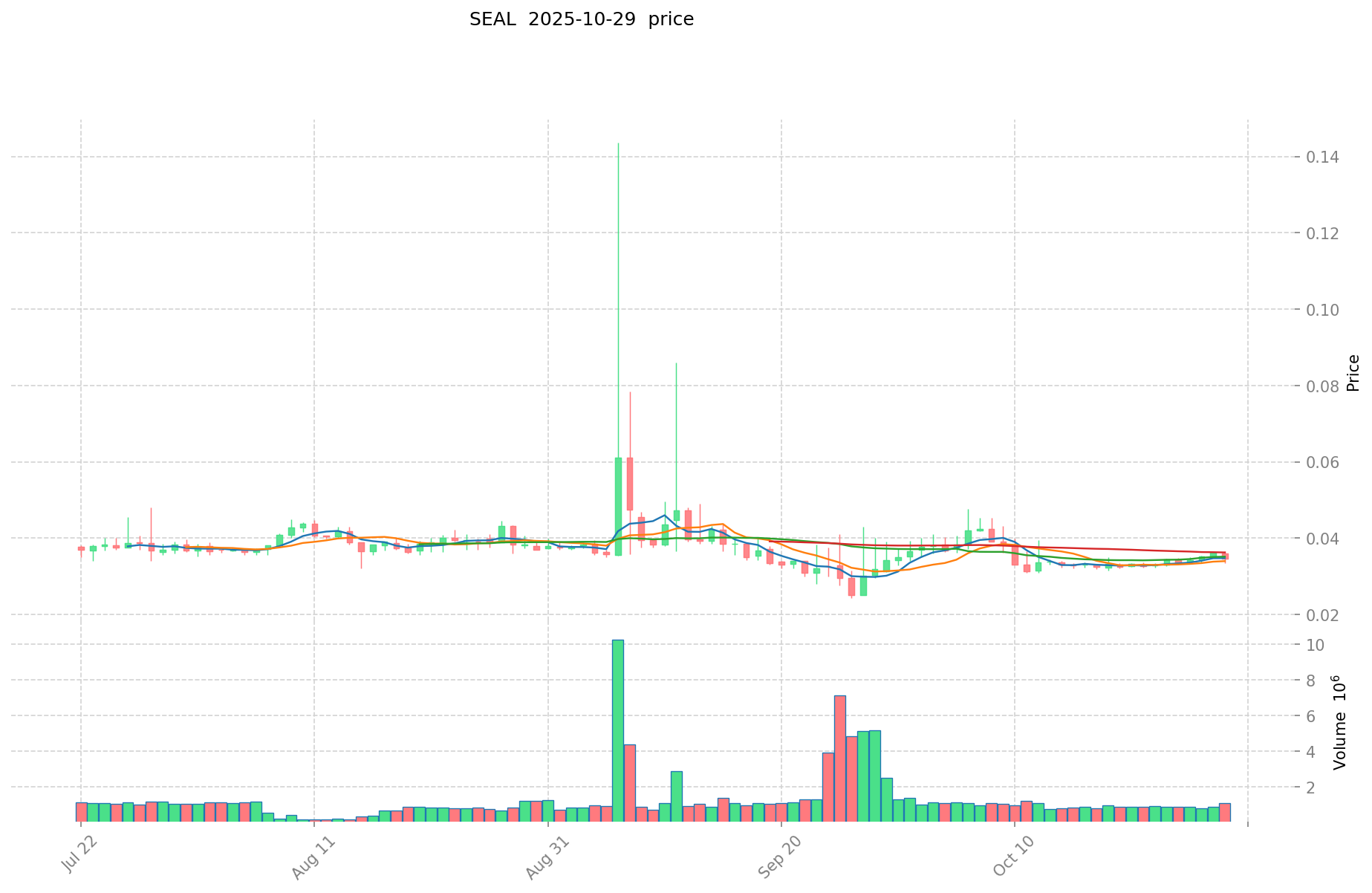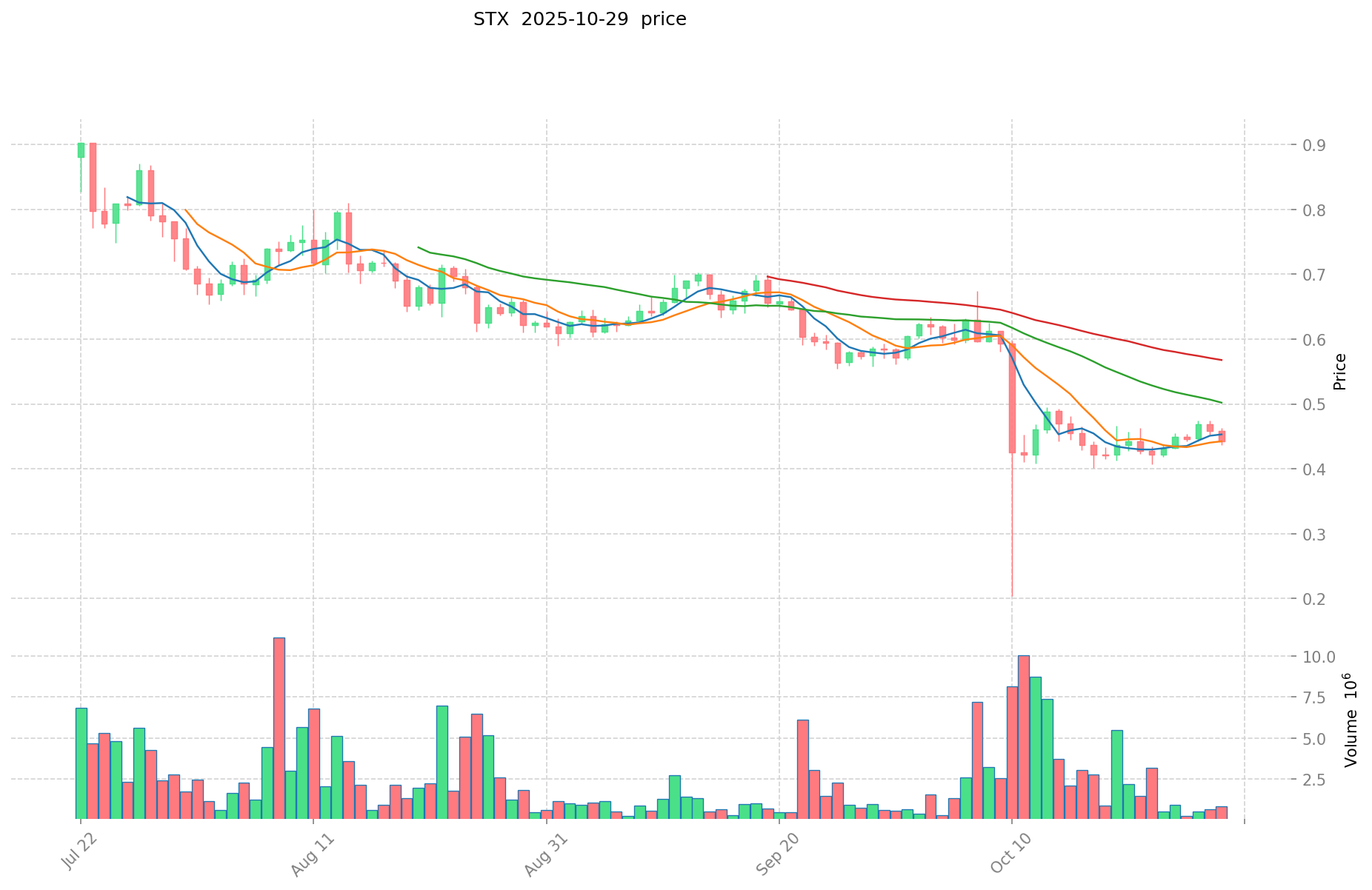SEAL vs STX: Comparing Two Promising Blockchain Platforms for Enterprise Solutions
Introduction: SEAL vs STX Investment Comparison
In the cryptocurrency market, the comparison between SEAL and STX has always been a topic that investors cannot avoid. The two not only have significant differences in market cap ranking, application scenarios, and price performance, but also represent different cryptocurrency asset positions.
SEAL (SEAL): Since its launch, it has gained market recognition as the first token issued on the RGB++ protocol (Bitcoin ecosystem) with free minting and full circulation.
STX (STX): Since its inception in 2019, it has been hailed as a "new Internet for decentralized applications," aiming to become the "Google" of blockchain.
This article will comprehensively analyze the investment value comparison between SEAL and STX, focusing on historical price trends, supply mechanisms, institutional adoption, technological ecosystems, and future predictions, and attempt to answer the question investors are most concerned about:
"Which is the better buy right now?"
I. Price History Comparison and Current Market Status
SEAL and STX Historical Price Trends
- 2024: SEAL reached its all-time high of $1.55 due to increased adoption of the RGB++ protocol.
- 2024: STX hit its peak price of $3.86, influenced by growing interest in Bitcoin layer-2 solutions.
- Comparative analysis: In the recent market cycle, SEAL dropped from $1.55 to a low of $0.0242, while STX declined from $3.86 to its current price of $0.4507.
Current Market Situation (2025-10-30)
- SEAL current price: $0.03486
- STX current price: $0.4507
- 24-hour trading volume: $37,962.34 (SEAL) vs $769,066.82 (STX)
- Market Sentiment Index (Fear & Greed Index): 51 (Neutral)
Click to view real-time prices:
- Check SEAL current price Market Price
- Check STX current price Market Price


Comparative Analysis of SEAL vs STX Investment Value Factors
Technical Innovation and Development
- STX: Positioned as a leading BTC layer 2 solution with significant Total Value Locked (TVL) of $600 million
- SEAL: Recently announced cross-chain staking reward program through Merlin Chain
- 📌 Technical Impact: Bitcoin ecosystem value logic is undergoing fundamental restructuring, with PoW security becoming a scarce resource attracting developers for smart contracts and asset issuance
Community Engagement and Support
- Market Response: Technical innovation combined with community resonance drives adoption
- User Activity: The synergy between technological advancement and community participation creates sustainable value
- Development Progress: Both projects rely on continuous improvement and community feedback
Market Performance Indicators
- Trading Volume: Initial response to new features can indicate market confidence
- TVL Comparison: STX currently maintains leadership position in BTC layer 2 solutions
- Investor Attraction: SEAL's cross-chain staking rewards designed to incentivize participation
Integration with Bitcoin Ecosystem
- STX Advantage: Already established as a leading Bitcoin layer 2 solution
- SEAL Opportunity: Cross-chain functionality potentially broadens use case beyond Bitcoin's ecosystem
- Ecosystem Value: Bitcoin's security foundation serves as the basis for both projects' value proposition
III. 2025-2030 Price Prediction: SEAL vs STX
Short-term Prediction (2025)
- SEAL: Conservative $0.0332 - $0.0350 | Optimistic $0.0350 - $0.0399
- STX: Conservative $0.2477 - $0.4505 | Optimistic $0.4505 - $0.5045
Mid-term Prediction (2027)
- SEAL may enter a growth phase, with expected price range of $0.0308 - $0.0505
- STX may enter a consolidation phase, with expected price range of $0.3233 - $0.5618
- Key drivers: Institutional fund inflows, ETFs, ecosystem development
Long-term Prediction (2030)
- SEAL: Base scenario $0.0432 - $0.0527 | Optimistic scenario $0.0527 - $0.0611
- STX: Base scenario $0.4624 - $0.6513 | Optimistic scenario $0.6513 - $0.8011
Disclaimer
SEAL:
| 年份 | 预测最高价 | 预测平均价格 | 预测最低价 | 涨跌幅 |
|---|---|---|---|---|
| 2025 | 0.0399114 | 0.03501 | 0.0332595 | 0 |
| 2026 | 0.041581377 | 0.0374607 | 0.032965416 | 7 |
| 2027 | 0.05058692928 | 0.0395210385 | 0.03082641003 | 13 |
| 2028 | 0.0554164001847 | 0.04505398389 | 0.0256807708173 | 29 |
| 2029 | 0.055258711241085 | 0.05023519203735 | 0.037174042107639 | 44 |
| 2030 | 0.061186463901492 | 0.052746951639217 | 0.043252500344158 | 51 |
STX:
| 年份 | 预测最高价 | 预测平均价格 | 预测最低价 | 涨跌幅 |
|---|---|---|---|---|
| 2025 | 0.50456 | 0.4505 | 0.247775 | 0 |
| 2026 | 0.5825866 | 0.47753 | 0.3247204 | 5 |
| 2027 | 0.561861798 | 0.5300583 | 0.323335563 | 17 |
| 2028 | 0.62239445586 | 0.545960049 | 0.51866204655 | 21 |
| 2029 | 0.7185380204889 | 0.58417725243 | 0.408924076701 | 29 |
| 2030 | 0.801169892845123 | 0.65135763645945 | 0.462463921886209 | 44 |
IV. Investment Strategy Comparison: SEAL vs STX
Long-term vs Short-term Investment Strategies
- SEAL: Suitable for investors focused on Bitcoin ecosystem potential and cross-chain functionality
- STX: Suitable for investors seeking established Bitcoin layer 2 solutions with significant TVL
Risk Management and Asset Allocation
- Conservative investors: SEAL: 30% vs STX: 70%
- Aggressive investors: SEAL: 60% vs STX: 40%
- Hedging tools: Stablecoin allocation, options, cross-currency portfolios
V. Potential Risk Comparison
Market Risks
- SEAL: Relatively new project, potentially higher volatility
- STX: Established project, but still subject to overall crypto market fluctuations
Technical Risks
- SEAL: Scalability, network stability of RGB++ protocol
- STX: Network congestion, potential security vulnerabilities in smart contracts
Regulatory Risks
- Global regulatory policies may impact both differently, with STX potentially facing more scrutiny due to its established position
VI. Conclusion: Which Is the Better Buy?
📌 Investment Value Summary:
- SEAL advantages: Cross-chain functionality, potential for growth in Bitcoin ecosystem
- STX advantages: Established Bitcoin layer 2 solution, significant TVL, proven track record
✅ Investment Advice:
- New investors: Consider a balanced approach, leaning towards STX for its established position
- Experienced investors: Explore SEAL for potential growth while maintaining STX exposure
- Institutional investors: Evaluate both for portfolio diversification, with emphasis on STX's current market position
⚠️ Risk Warning: The cryptocurrency market is highly volatile. This article does not constitute investment advice. None
FAQ
Q1: What are the key differences between SEAL and STX? A: SEAL is a newer token issued on the RGB++ protocol in the Bitcoin ecosystem, while STX is an established Bitcoin layer 2 solution launched in 2019. STX has a higher market cap, trading volume, and Total Value Locked (TVL) compared to SEAL.
Q2: How do the current prices of SEAL and STX compare? A: As of 2025-10-30, SEAL's price is $0.03486, while STX's price is $0.4507. STX is trading at a significantly higher price than SEAL.
Q3: What are the main advantages of investing in SEAL? A: SEAL offers potential growth opportunities within the Bitcoin ecosystem, cross-chain functionality, and recently announced a cross-chain staking reward program through Merlin Chain.
Q4: What are the primary benefits of investing in STX? A: STX is an established Bitcoin layer 2 solution with significant Total Value Locked (TVL) of $600 million, a proven track record, and is positioned as a leading platform for decentralized applications on Bitcoin.
Q5: How do the long-term price predictions for SEAL and STX compare? A: By 2030, SEAL's base scenario predicts a price range of $0.0432 - $0.0527, while STX's base scenario predicts a range of $0.4624 - $0.6513. STX is projected to maintain a higher price point compared to SEAL.
Q6: What are the recommended investment strategies for SEAL and STX? A: For conservative investors, a suggested allocation is 30% SEAL and 70% STX. For aggressive investors, the recommendation is 60% SEAL and 40% STX. New investors might consider leaning towards STX for its established position, while experienced investors could explore SEAL for potential growth.
Q7: What are the main risks associated with investing in SEAL and STX? A: SEAL, being a newer project, may face higher volatility and technical risks related to the RGB++ protocol. STX, while more established, could face regulatory scrutiny and potential smart contract vulnerabilities. Both are subject to overall crypto market fluctuations and regulatory risks.
Share
Content